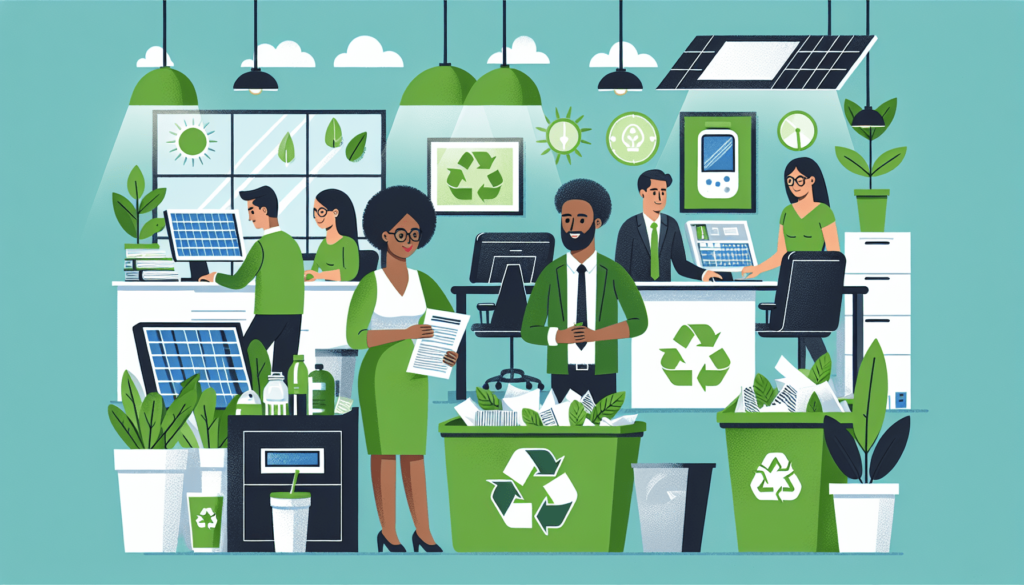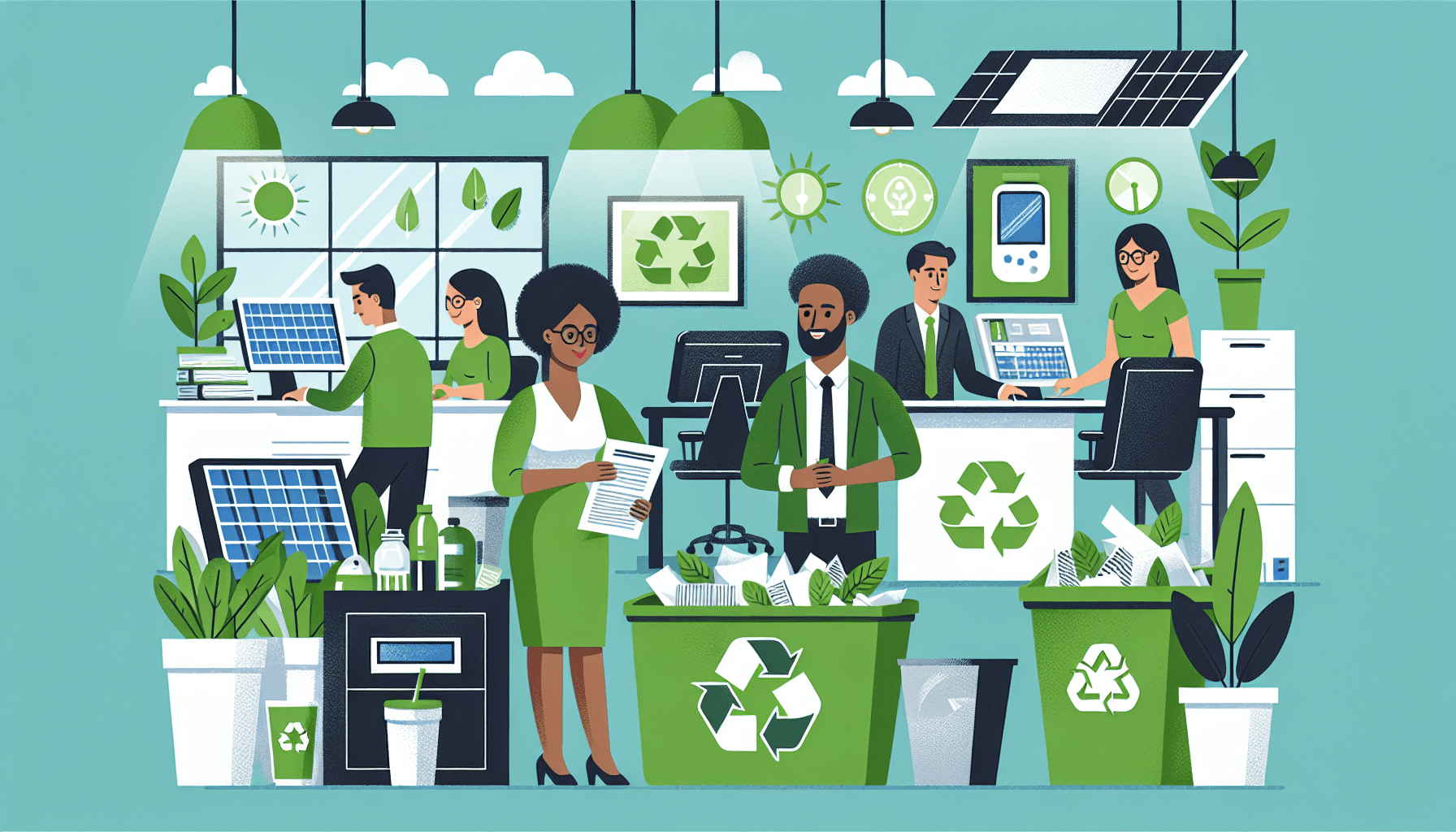Imagine if you could make a positive impact on the environment without leaving the comfort of your desk. With the increasing awareness of the need to reduce waste, there is a growing shift towards eco-friendly office practices. By implementing simple yet effective measures, you can contribute to a greener future while still being productive at work. Learn how to adopt sustainable habits and reduce waste in your workplace with our guide to eco-friendly office practices.

Implement a Recycling Program
Set up designated recycling bins
Setting up designated recycling bins in your office is an essential first step in implementing a recycling program. Place these bins strategically in easily accessible areas throughout the office, such as near printer stations, break rooms, and common areas. Clearly label each bin so that employees know what specific materials should be placed in each one, such as paper, plastic, glass, and metal. By making recycling convenient and visible, you can encourage employees to participate and make it a habit.
Educate employees on what can and cannot be recycled
It is crucial to educate your employees on what can and cannot be recycled to ensure that the recycling program is effective. Create informative posters or handouts that outline what items can be recycled and provide examples of materials that should not be placed in the recycling bins. Common items that are recyclable include paper, cardboard, aluminum cans, plastic bottles, and glass jars. However, it’s important to teach employees about restrictions such as not recycling dirty or contaminated items, plastic bags, or food waste. Regularly remind employees of the recycling guidelines and answer any questions they may have to maintain a successful recycling program.
Partner with a recycling company
To take your recycling efforts to the next level, consider partnering with a reputable recycling company. These companies specialize in collecting and processing recyclable materials, ensuring that they are properly sorted and recycled. Research and select a recycling company that aligns with your sustainability goals and has a track record of environmentally-friendly practices. Partnering with a recycling company not only streamlines your recycling process but also provides valuable expertise and resources to improve your recycling program.
Regularly monitor and measure recycling efforts
To gauge the effectiveness of your recycling program, it is important to regularly monitor and measure your recycling efforts. Establish a system to track the amount of recyclable materials collected and compare it to previous months or years. This data will give you insights into the progress you are making and help identify areas for improvement. Consider setting goals for increasing recycling rates and reducing waste. Celebrate milestones with your employees to keep them motivated and engaged. By continuously monitoring and measuring your recycling efforts, you can adapt and refine your program to ensure maximum impact.
Reduce Paper Usage
Encourage digital communication and documentation
One of the most effective ways to reduce paper usage in the office is to encourage digital communication and documentation. Utilize email, instant messaging platforms, and project management tools to share information and collaborate. Instead of printing and distributing paper memos or handouts, consider sending electronic versions that can be easily accessed and archived. Encourage employees to send electronic files instead of faxing or printing unnecessary documents. By embracing digital platforms, you can significantly minimize paper consumption and create a more efficient and eco-friendly work environment.
Print double-sided whenever possible
When printing is necessary, make it a habit to print double-sided whenever possible. Adjust your printer settings so that double-sided printing is the default option. This simple adjustment can cut paper consumption in half. Encourage employees to follow this practice by reminding them to select the double-sided option when printing documents. Additionally, when reviewing drafts or making edits, encourage the use of digital annotations and comments rather than printing multiple copies.
Provide reusable notebooks or whiteboards for meetings
Incorporating reusable notebooks or whiteboards into your meeting rooms can greatly reduce paper waste. Provide employees with reusable notebooks or whiteboards, allowing them to take notes or brainstorm ideas without consuming traditional paper. These reusable options are easily erasable, allowing for multiple uses. Not only does this practice save paper, but it also promotes a more collaborative and interactive meeting environment. Make sure to have a supply of markers or pens that are suitable for these reusable surfaces readily available.
Implement a paperless invoicing and billing system
Transitioning to a paperless invoicing and billing system can have a significant impact on reducing paper waste in your office. Instead of printing and mailing invoices or bills, send them electronically to your clients or customers. Choose an online platform or software that allows you to create and send invoices digitally, track payments, and store records securely. Encourage your clients and customers to opt for electronic billing and offer incentives for those who make the switch. By embracing a paperless system, you not only save paper but also streamline your administrative processes.
Conserve Energy
Switch to energy-efficient LED light bulbs
One of the easiest and most impactful ways to conserve energy in your office is by switching to energy-efficient LED light bulbs. LED bulbs are more energy-efficient and have a significantly longer lifespan compared to traditional incandescent or fluorescent bulbs. Replace all existing light bulbs with LED alternatives, ensuring that they have the appropriate brightness and color temperature for different areas of your office. Encourage employees to turn off lights when they are not in use and utilize natural lighting whenever possible.
Turn off lights and devices when not in use
Encourage a culture of energy conservation by reminding employees to turn off lights and devices when they are not in use. Develop simple reminders and post them near light switches, office equipment, and common areas. Consider installing motion-sensor lighting in less frequently used areas to ensure that lights are automatically turned off when no one is present. Encourage employees to power down their computers and unplug chargers when they leave for the day. By adopting these habits, you can significantly reduce your office’s energy consumption and contribute to a greener environment.
Use natural lighting and adjust blinds accordingly
Make the most of natural lighting in your office by adjusting blinds accordingly. Open blinds during daytime hours to allow natural light to illuminate workspaces and reduce the need for artificial lighting. Employee workstations should be positioned to maximize access to natural light while minimizing glare and heat. Encourage employees to take advantage of natural lighting by aligning their workstations accordingly. Not only does natural light save energy, but it also promotes a more comfortable and pleasant working environment.
Upgrade to energy-efficient office equipment
Consider upgrading your office equipment to energy-efficient alternatives. When purchasing new computers, printers, scanners, or any other office equipment, look for energy-efficient models with Energy Star certification. These devices consume less energy while delivering the same performance. Conduct an audit of your current equipment to determine which devices are no longer energy-efficient and should be replaced. Properly dispose of outdated equipment by recycling or donating them to minimize electronic waste.
Promote Sustainable Transportation
Encourage carpooling or the use of public transportation
Encouraging employees to carpool or use public transportation is an excellent way to promote sustainable transportation practices. Promote the benefits of carpooling, such as reducing carbon emissions, decreasing traffic congestion, and saving money on fuel costs. Provide designated carpool parking spaces to make it convenient for employees to find carpool partners. Offer incentives such as preferred parking spots or subsidies for public transportation passes to encourage the use of public transportation. By actively promoting sustainable commuting options, you can contribute to a greener and less congested community.
Provide secure bicycle storage and facilities
Encourage employees to embrace cycling for their daily commute by providing secure bicycle storage and facilities. Install bike racks or bicycle storage rooms that are easily accessible and well-lit. Ensure that these spaces are adequately protected from theft or damage. Consider providing basic tools and equipment such as tire pumps or repair kits for employees to quickly fix any issues with their bicycles. Additionally, offer changing rooms or shower facilities for employees who choose to cycle to work. By supporting cycling as a viable transportation option, you not only reduce carbon emissions but also promote a healthier and more active lifestyle for your employees.
Support telecommuting and flexible work hours
Supporting telecommuting and offering flexible work hours can have a significant impact on reducing commuting-related carbon emissions. Allow employees to work remotely a few days a week or provide flexible work schedules that allow them to avoid peak traffic hours. This flexibility not only reduces the number of cars on the road but also promotes work-life balance and employee satisfaction. Ensure that employees have the necessary tools and technology to effectively work from home, and establish clear communication channels to maintain productivity and collaboration. By embracing these practices, you can contribute to a more sustainable work environment while providing your employees with greater flexibility.
Participate in work-from-home initiatives
Consider participating in work-from-home initiatives or campaigns organized by local or national organizations. These initiatives often aim to reduce traffic congestion, improve air quality, and promote sustainable commuting practices. By joining such initiatives, you can align your company with broader sustainability goals and demonstrate your commitment to environmental stewardship. Promote these initiatives among your employees, provide resources or training to ensure a smooth transition to remote work, and measure and report the positive impact on carbon emissions reduction. By actively participating, you can be part of a larger movement towards a greener future.

Use Green Cleaning Products
Switch to environmentally-friendly cleaning supplies
Switching to environmentally-friendly cleaning supplies is a crucial step in creating a greener and healthier office environment. Traditional cleaning products often contain harmful chemicals that can be detrimental to both human health and the environment. Replace these products with eco-friendly alternatives that are made from natural ingredients and have minimal impact on air quality and water systems. Look for certifications such as Green Seal or EcoLogo to ensure that the cleaning supplies meet strict environmental standards. By using green cleaning products, you promote a safer and more sustainable workspace for your employees.
Choose products with biodegradable and non-toxic ingredients
When selecting cleaning supplies, prioritize products with biodegradable and non-toxic ingredients. These products break down naturally in the environment, minimizing their impact on ecosystems. Avoid any products that contain phosphates, chlorine, artificial fragrances, or other harmful chemicals. Instead, opt for products made from plant-based ingredients and natural essential oils. Ensure that all cleaning staff are trained in the proper use of these products to maximize their effectiveness and minimize waste. By making this switch, you contribute to a healthier workplace and help protect the environment.
Partner with eco-conscious cleaning companies
Consider partnering with cleaning companies that share your commitment to sustainability. Many professional cleaning services have embraced eco-friendly practices and use green cleaning products as part of their service offerings. Research and select a cleaning service that aligns with your sustainability goals and has a reputation for eco-conscious practices. Work with them to develop customized cleaning plans that incorporate efficient cleaning techniques and the use of green products. Regularly assess the cleaning company’s performance and provide feedback to ensure that sustainability practices are maintained. By partnering with an eco-conscious cleaning company, you extend your commitment to sustainability beyond your own office walls.
Reduce Water Waste
Repair leaks and drips promptly
One of the most effective ways to reduce water waste in your office is by promptly repairing leaks and drips. Leaking faucets, toilets, or pipes can contribute to significant water wastage over time. Regularly inspect your office plumbing systems to identify any leaks or drips and have them repaired promptly. Educate your employees on how to report plumbing issues and encourage them to notify maintenance staff as soon as they notice a problem. By addressing water leaks promptly, you minimize water waste and decrease your environmental footprint.
Install water-saving fixtures and faucets
Installing water-saving fixtures and faucets is an excellent investment towards reducing water waste in your office. Replace old or inefficient fixtures with low-flow alternatives that regulate and conserve water usage. Install aerators on faucets to control water flow rates without compromising performance. Consider installing automatic shut-off valves or sensor-activated faucets in areas where hands-free operation is feasible. Upgrade your office toilets to low-flow or dual-flush models that use significantly less water per flush. By implementing these measures, you can significantly reduce your water consumption and contribute to water conservation efforts.
Promote water conservation practices among employees
Promoting water conservation practices among your employees can have a collective impact on reducing water waste. Educate employees about the importance of water conservation and provide tips on how they can conserve water in their daily activities. Encourage employees to adopt simple practices, such as turning off the faucet while brushing their teeth or using a water-saving showerhead at home. In the office, encourage employees to report any water leaks or wastage they observe and provide incentives for water-saving suggestions or initiatives. By engaging your employees in water conservation efforts, you create a culture of environmental responsibility.
Reuse water where possible (e.g. for plants)
Reuse water whenever possible to minimize water waste. One way to do this is by collecting and reusing water for plants in the office. Set up rainwater collection systems or collect and store water from fountains or air conditioning condensation for watering plants. Educate employees on the importance of reusing water and provide designated containers or systems for collecting it. By reusing water for irrigation purposes, you can reduce your reliance on freshwater sources and promote sustainable water management practices.
Minimize Food Waste
Encourage employees to bring reusable containers and utensils for lunch
Encourage your employees to bring their own reusable containers and utensils for lunch to help minimize food waste. Provide a designated area in the office, such as a break room or pantry, where employees can store their reusable containers and utensils. Promote the use of these items by highlighting the environmental benefits of reducing single-use plastic waste. Consider providing incentives for employees who consistently use reusable containers and utensils, such as discounts or rewards at local businesses. By encouraging this practice, you reduce the amount of waste generated from disposable food containers and cutlery.
Provide communal refrigerators and composting facilities
Set up communal refrigerators and composting facilities in your office to minimize food waste. Designated refrigerators allow employees to store and share perishable items, reducing the chances of food going to waste. Encourage employees to label their items and promote a “take only what you need” culture to prevent food from being left unused. Additionally, provide composting facilities where employees can dispose of food scraps. Composting diverts organic waste from landfills and creates nutrient-rich soil that can be used in community gardens or donated to local farms. By providing these resources, you promote sustainable food practices and reduce the environmental impact of food waste.
Coordinate with local food banks or charities for surplus food
To further minimize food waste, coordinate with local food banks or charities to donate surplus food from your office. Research local organizations that accept donations of perishable and non-perishable food items. Establish a system for collecting and safely storing surplus food, ensuring that the quality and safety of the food are maintained. Arrange for regular pickups or deliveries with the chosen organization to ensure that the food reaches those in need. By donating surplus food, you not only help reduce food waste but also contribute to addressing food insecurity in your community.
Promote mindful eating and portion control
Promote mindful eating and portion control among your employees to minimize food waste. Encourage employees to be conscious of their food choices and consider portion sizes when preparing meals or ordering food. Provide educational resources or invite nutritionists to speak about the benefits of mindful eating, healthy portion sizes, and meal planning. Encourage employees to finish their meals or take home any leftovers rather than wasting food. By promoting mindful eating practices, you help employees make sustainable food choices while reducing unnecessary food waste.
Donate and Recycle Electronics
Establish a collection program for old electronics
Establishing a collection program for old electronics allows you to properly dispose of electronic waste and prevent it from ending up in landfills. Set up designated collection points where employees can drop off their unwanted or outdated electronic devices. Clearly communicate the type of electronics that are accepted and establish a schedule for recycling pickups or drop-offs with certified e-waste recycling facilities. Ensure that data security measures are in place to protect sensitive information before recycling or disposing of electronic devices. By collecting and recycling electronics responsibly, you contribute to a circular economy and reduce the environmental impact of electronic waste.
Partner with certified e-waste recycling facilities
Partnering with certified e-waste recycling facilities ensures that your old electronics are properly recycled and disposed of. Research local recycling facilities that specialize in the responsible management of electronic waste. Choose reputable facilities that adhere to strict environmental standards and have certifications such as R2 (Responsible Recycling) or e-Stewards. Ensure that the facilities have proper procedures in place to securely erase data from devices before recycling. By partnering with certified e-waste recycling facilities, you can be confident that your electronic waste is being handled in an environmentally-friendly and sustainable manner.
Consider donating functional electronics to schools or non-profit organizations
Consider donating functional electronics that are no longer needed to schools or non-profit organizations. Many schools and charitable organizations are in need of computers, tablets, or other electronic devices to support their educational or outreach programs. Reach out to local schools, community centers, or non-profit organizations to inquire about their technology needs and donation policies. Before donating, ensure that the devices are in good working condition and suitable for the recipient’s requirements. By donating functional electronics, you extend the life cycle of these devices and provide valuable resources to those who can benefit from them.
Source Sustainable Office Supplies
Choose eco-friendly and recycled paper products
When sourcing office supplies, prioritize eco-friendly and recycled paper products. Look for paper that is certified by reputable organizations such as the Forest Stewardship Council (FSC), indicating that it was sourced sustainably from responsibly managed forests. Opt for recycled paper products whenever possible, such as copy paper, notebooks, and notepads. Many suppliers offer a range of recycled paper options, allowing you to select the highest post-consumer waste content available. By choosing eco-friendly and recycled paper products, you support sustainable forestry practices and reduce the demand for virgin paper production.
Opt for refillable ink cartridges and pens
Choosing refillable ink cartridges and pens reduces plastic waste and saves resources. Instead of using single-use ink cartridges, select printers that allow for the use of refillable ink tanks. Refillable ink cartridges provide a cost-effective and eco-friendly option, as they can be refilled multiple times before needing replacement. When it comes to pens, opt for refillable ones instead of disposable options. Many brands offer refillable ink cartridges or ink refills that can be easily inserted into compatible pen barrels. By using refillable ink cartridges and pens, you decrease plastic waste and contribute to a more sustainable office environment.
Select office furniture made from sustainable materials
When purchasing office furniture, prioritize items made from sustainable materials. Look for furniture made from recycled or upcycled materials, such as desks or chairs crafted from reclaimed wood or recycled plastic. Choose pieces that are designed to last, using durable materials that can withstand everyday use. Avoid furniture made from materials that are harmful to the environment, such as furniture treated with toxic chemicals or derived from endangered wood species. Research and select suppliers that prioritize sustainability and have certifications such as Forest Stewardship Council (FSC) or Leadership in Energy and Environmental Design (LEED). By selecting sustainable office furniture, you minimize your environmental impact and support responsible manufacturing practices.
Research suppliers with a commitment to sustainability
Research and partner with suppliers who share your commitment to sustainability. Look for suppliers that have clear sustainability policies and demonstrate their dedication to environmentally-friendly practices. Inquire about their product sourcing methods, packaging materials, and recycling programs. Choose suppliers that prioritize the use of sustainable materials, reduce packaging waste, and offer recycling services for their products. Establish long-term relationships with these suppliers and collaborate on continuous improvement initiatives. By partnering with suppliers who prioritize sustainability, you send a message about your company’s values and contribute to a more sustainable supply chain.
Educate and Involve Employees
Provide eco-friendly training and resources
Educating your employees about eco-friendly practices and providing them with the necessary resources is crucial to fostering a sustainable work environment. Develop comprehensive training programs that outline the importance of sustainability and provide practical tips on how employees can contribute to a greener workplace. Offer resources such as handouts, videos, or online modules that employees can access at their convenience. Incorporate sustainability topics into regular employee meetings or newsletters to reinforce the importance of ongoing environmental initiatives. By providing eco-friendly training and resources, you empower your employees to be active participants in your sustainability efforts.
Encourage employee suggestions and feedback on sustainability initiatives
Encourage your employees to actively engage in sustainability initiatives by soliciting their suggestions and feedback. Create a dedicated channel for employees to submit their ideas or proposals for sustainable practices. Establish a system for reviewing and implementing these suggestions, recognizing the ideas and contributions of your employees. Actively seek feedback from employees to assess their level of satisfaction and engagement with existing sustainability initiatives. By involving your employees in the decision-making process and valuing their input, you promote a sense of ownership and commitment to your sustainability goals.
Organize green team or sustainability committees
Organizing a green team or sustainability committee within your office can help drive and sustain your eco-friendly initiatives. Encourage employees to volunteer and form a team dedicated to creating and implementing sustainability initiatives. This team can be responsible for researching best practices, organizing awareness campaigns, and coordinating educational events. Empower the green team or sustainability committee to serve as ambassadors and advocates for sustainability within the office. Regularly meet with the team to review progress, address challenges, and generate new ideas. By establishing a green team, you create a core group of employees who are passionate about sustainability and can inspire others to get involved.
Recognize and reward environmentally-conscious behavior
Recognize and reward environmentally-conscious behavior to motivate and reinforce sustainable practices among your employees. Develop a recognition program that celebrates individuals or teams who demonstrate exceptional commitment to sustainability initiatives. Offer incentives such as gift cards, additional paid time off, or company-wide recognition for achievements in reducing waste, conserving energy, or implementing innovative sustainability practices. Highlight these accomplishments in newsletters, social media, or internal communications to inspire others and cultivate a culture of environmental stewardship. By recognizing and rewarding environmentally-conscious behavior, you create a positive and inspiring work environment that encourages sustainable practices.

